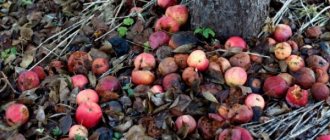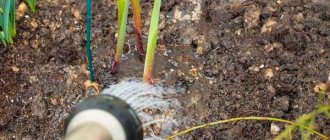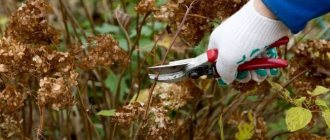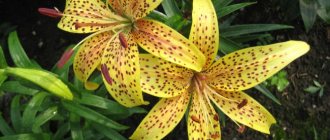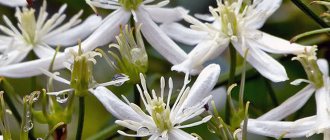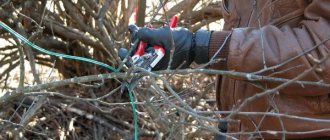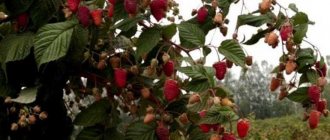Autumn is not only the richest time of the year, when, along with harvesting all kinds of crops, there is literally a struggle of preparing various canned goods for future use - we work, like that fabled Ant, so as not to become the same fabled Dragonfly. In addition, we gradually need to get into the rhythm of preparing the garden plot for winter, so that everything doesn’t fall at once, and we shouldn’t discount weather conditions - they can reschedule all our intentions and possibilities, especially if the plot is not outside the threshold of our home, but on removal.
Preparing the garden for winter is a multifaceted job: cleaning up fallen leaves; pruning and whitewashing of trees and shrubs - plus their treatment with pesticides against wintering pests of all types; strawberry processing; lawn improvement; winter fertilization of all plants; digging up the soil with the expectation of planting next season; planting and sowing flower seeds and bulbs; preparing plants for shelter in frosty regions; conservation or equipment of greenhouse devices, stationary greenhouses, and so on. Let’s not forget that only our eyes are cowardly—our hands are much bolder!
You need to start preparing your garden for winter in August, because some beds and flower beds have already served their purpose and need to be cleared of wilted plants and disposed of. Fruit trees have dropped inferior fruit - all should be removed without accumulating food for slugs. The fight against weeds, which steal moisture and soil fertility, is still ongoing.
- Preparing fruit trees for winter Autumn pruning of trees
- Whitewashing tree trunks
- Watering plants before winter
September is a strict and responsible month. He sums up our harvest successes and hurries us through the work of preparing the garden plot for winter. At the beginning of autumn, in dry weather, fruits of late varieties are carefully collected, while simultaneously sorting by quality, placing them correctly for storage and transportation in suitable containers. Experienced gardeners sprinkle packaged pears and apples with dry sawdust for both transportation and storage.
Preparing fruit trees for winter
It is in September that it is advisable to carry out all measures to prepare fruit trees for winter and you can start with an audit of the bark and crown. Trim dried branches, dead areas, lichens, moss, wounds and growths on the bark and treat accordingly - cover with garden varnish or old light-colored oil paint.
In addition, remove all traps and hunting belts - paper ones - for scrap, and wash, dry and store fabric ones until spring.
Autumn tree pruning
Even in the first days of November, you will still have time to painlessly trim dry, diseased and mechanically damaged shoots, branches and unnecessary growth for trees and shrubs, carefully treating small cuts with a solution of copper sulfate, and covering larger cuts with a layer of garden varnish or old oil paint .
Don’t forget to cut branches only above the bud directed towards the outside of the bush.
In trees that have undergone grafting actions, the grafting windings should be loosened and replaced with higher grafting pegs. In November, it is appropriate to prepare cuttings of grafting material for spring work with them.
We recommend reading in more detail about the schemes and timing of autumn pruning of an apple tree, as well as how to properly prune an apricot.
Whitewashing tree trunks
Whitewashing of tree trunks is carried out in dry sunny weather. The purpose of this action is to protect against wintering pests and prevent early spring sunburn. You can do this with ready-made whitewash for garden consumption, purchased in a store, or prepare it from 3 kilograms of lime with the addition of 500 grams of copper sulfate per bucket of water.
Watering plants before winter
September watering of the garden is carried out, if necessary, through a home-grown soil moisture test. To do this, dig a narrow hole 40 centimeters deep, remove a handful of soil from its bottom and squeeze it in the palm of your hand. If the lump does not crumble, then watering can not be started or stopped.
No one has canceled the necessary dosed watering of plants before winter, especially in conditions of too dry autumn. Pome fruit trees that have produced their late harvest of fruits need additional watering, which can be done in a targeted manner in four shallow holes, evenly distributed along the ring of the crown of each tree, pour in 1 bucket of water, and mulch the holes and even the entire tree trunk to retain moisture with organic soil or coniferous spruce branches.
It is advisable to carry out gradual watering with water, which should be 5 degrees C warmer than the air temperature, with an interval of 12-15 liters per hour, so that the depth of moisture accumulation reaches at least 1 meter.
Autumn care of shrubs and preparation for winter
After the leaves of the berry bushes fall, they are pruned sanitarily. At the same time, excess, diseased, weak, dried out or damaged shoots are cut out. Oblique cuts should be made above the buds, directed towards the outside of the bush.
In black currant bushes, all branches older than five years are also removed; in white and red currants, shoots over 8 years old are cut off at the root. On such shoots, ovaries no longer form; after their removal, all nutrition goes to the fruiting shoots.
On a note!
After pruning, a fertilizer containing phosphorus and potassium should be applied to each bush. Usually, a tablespoon of superphosphate and any potassium salt is added to each bush.
Gooseberries are also pruned in preparation for winter. All bushes older than 6 years must be pruned. During the pruning process, all old, diseased and dry branches are removed, and root growth is also removed. After pruning, 2 tbsp are placed in the root zone of the plants. l. superphosphate to a depth of 5 cm. You should also add 1 tbsp. l. potassium salts and 200-300 g of wood ash.
In the fall of non-remontant raspberry varieties, all last year's shoots are removed at the root, and young shoots are bent to the soil and covered with spruce branches or other covering material. Also in the fall, under each raspberry bush you need to add rotted manure - up to 5-6 kg for each square of area.
If all autumn procedures for caring for garden crops are carried out correctly and in a timely manner, then next season they will thank their owners with abundant fruiting.
Autumn feeding and fertilizers
An important stage is autumn feeding of apple and pear trees. It is necessary to add at least 5 kilograms of organic matter per square meter for each tree; up to 10 grams - potassium mineral fertilizers; 40 grams of superphosphate, which, combined with sufficient moisture, will provide fruit trees with everything they need for wintering, during which they will retain vegetative strength for the future harvest.
Very important! You cannot include nitrogen mineral fertilizers in autumn fertilizing, which, as everyone knows, activates active growth processes that are undesirable at this time of year, which reduces the winter hardiness of garden crops.
Of the organic fertilizers widely known to us, slurry is used in autumn feeding at the rate of: 1:10; compost for trees from 1 to 7 years old at the rate of: 1.5-2.0 kilograms per square meter of trunk circle, and for older trees - 2-3 kilograms; ash at the rate of: 100 grams per bucket of water; humus: half a bucket per square meter.
Top dressing with mineral fertilizers, in addition to nitrogen, also remains important. It is carried out in four wells-points with an aqueous solution based on four buckets of the specified solution per square meter of the tree trunk circle:
- trees up to 10 years of growth - 2 tablespoons of superphosphate and 1 tablespoon of sodium chloride;
- trees over 10 years old - 4 tablespoons of superphosphate and 2 tablespoons of potassium chloride per bucket of water;
- cherry and plum - 3 tablespoons of superphosphate and 2 tablespoons of potassium sulfate per 10 liters of water.
Berry bushes - currants and gooseberries - need fertilizing, which is advisable to combine with loosening the soil of the root circle and row spacing with a fork, sparing the root system of the bushes.
Feed garden strawberries and strawberries of remontant varieties along the grooves previously drawn along their planting with a hoe, with a water infusion of mullein at the rate of: 1:15 or bird droppings: 1:30 with the addition of a small amount of ash. We have already talked in more detail about the types of autumn feeding of strawberries in a previous article.
All grape varieties need not only spring processing, but also proper care in the autumn. Grape bushes prefer manure, which is appropriate to introduce within 6 kilograms per square meter during autumn digging.
Tree care
Preparing garden trees for winter involves sanitary pruning of branches, harvesting fruits and fallen leaves, loosening the soil and fertilizing. To protect against pests and temperature changes, the trunks are covered with whitewash.
Pruning branches before winter
Frost-resistant trees with stone fruits are subjected to autumn pruning: apple trees, pears, plums, etc.
The following are removed from the trunks:
- broken, old and dry branches;
- shoots crossing each other or growing towards the trunk;
- weak, too thin branches;
- shoots infected with pests;
- tops (strong young shoots with large leaves that grew in places where large branches were damaged);
- young growth near the roots.
Thinning allows you to improve the heating, lighting and ventilation of the plant. The crown shape can be tiered or cup-shaped. Shoots on trees of the first year of growth are carefully shortened.
Pruning is carried out with a lopper or pruning shears. The first tool is designed to work with branches with a diameter of up to 40 mm, and the second - up to 25 mm. After trimming the tops, the cut areas are treated with garden varnish or oil paint.
For beginning gardeners, educational videos on rejuvenating and sanitary pruning of branches will be useful.
Fertilizer application
Fertilizing is done after harvesting.
The following fertilizers are used to saturate the soil:
- superphosphate;
- potassium (chlorine, sulfate);
- phosphorus-potassium.
Beneficial substances are introduced under the roots of trees while loosening the soil. Nitrogen compounds are not used before cold weather, because... they provoke the rapid development of young shoots. If there is an excess of nitrogen in the warm season, the garden owner will have to work hard to remove the tops.
In autumn, dry fertilizing should be used. In this case, the fertilizers will be gradually absorbed by the root system when dissolved in rain and melt water.
After adding potassium and phosphorus, the ground is covered with a mixture of ash and river sand in a 1:1 ratio. For each square meter of prepared soil, take 0.5 buckets of the mixture.
After loosening and saturating the soil, the tree trunk area is covered with pine needles, mown grass or other mulch.
Phosphorus-potassium fertilizers should be applied immediately before snowfall
Leaf cleaning
Removing fallen leaves is the first step in preparing the garden for winter. Foliage can be collected by hand or with a rake. If it is not infested with pests, then it can be placed in a compost bin. Otherwise, the leaves are burned along with other crops that are unsuitable for compost (potato and nightshade tops, untimely cut and diseased berry bushes, etc.).
A special product (“Kompostin”, “Baikal EM-1”) is added to the leaves and tops for composting. After this, they are placed in a compost pit and mixed with old layers of fertilizer.
In addition to fallen leaves, lichens, moss and loose pieces of bark are removed from trees.
Whitewashing trunks
Whitewashing trunks allows you to protect trees not only from pests, but also from the first sunburn in the spring. Bare dark trunks absorb light well and heat up, so the process of sap movement and bud ripening begins when it is still too cold. The bright white coating reflects light and prevents premature heating.
The composition for whitewashing consists of the following components:
- 10 liters of water;
- 500 g of copper sulfate;
- 2.5-3 kg of lime;
- 100 g wood glue (to increase adhesion to bark).
The lime mixture is suitable for trees older than 3-5 years. For young plants, it is recommended to use acrylic or water-based paint. The paint can must say “For Garden Trees.” It is prohibited to use paint for painting work.
The height of the whitewash corresponds to 1 meter or the level of the lowest branches of the tree.
To protect against pests, you can also use polymer mesh with a fine mesh. They wrap the trunk, lightly pressing the nearest branches to it.
Whitewashing trees prevents premature heating of the trunk
Protecting plants from diseases and pests in autumn
October is the most deciduous month. And you should not accumulate heaps of fallen leaves, but in any dry weather, while they are dry and light, rush to collect them and burn them in special iron containers.
Left to naturally rot, fallen leaves become an excellent winter habitat for numerous garden pests, including naked slugs. Even as a covering material or for humus, it has recently not been recommended to use them, since over the course of the season the leaves accumulate pathogens and, possibly, harmful chemicals.
Autumn garden plan
Proper autumn care for an orchard begins in September and ends two weeks before the first frost. In order not to miss anything, it is recommended to draw up a preliminary plan depending on the region of residence, and, based on it, carry out all relevant activities. Basic garden care activities include:
- carrion is collected from the ground, pests are destroyed;
- planting young seedlings in October, when there is frequent rain and a significant cooling is felt;
- pruning fruit-bearing plants;
- whitewashing tree trunks;
- carry out preventive work against fungus and rot;
- treatment of branches and trunks from insects hiding inside;
- collecting fallen leaves and pruned branches and burning them;
- digging up trees;
- feeding and fertilizing plants.
If necessary, the plants are insulated and protected from rodents. Young seedlings need to be protected especially carefully, as they are more susceptible to attack by rodents and pests.
Whitewashing trunks
Whitewashing fruit trees in autumn is very important. It protects the plant from:
- From insects that lay their larvae and harm the plant.
- Protection against temperature changes. During the daytime, the bark warms up from the sun's rays, and at night and in the evening it is exposed to severe frosts.
- When the tree has not yet covered with leaves in the spring, whitewashing protects it from burns.
- Protection against fungal diseases.
Interesting!
The whitewash should be rich and thick. It covers the base of the trunk, and, if possible, the base of the skeletal branches. For young trees, chalk is used instead of lime.
The solution is prepared in several ways. The simplest solution is considered to be lime, copper sulfate and water. For 10 liters of water you will need 2 kg of lime and 400 grams of copper sulfate. You can add a little paste to the solution to increase the viscosity, as well as cow dung or 1 kg of clay.
However, when caring for young trees, you should remember that paste is not used to whiten them. It does not allow air to penetrate to the bark. For young fruit trees, a solution is prepared from 1.5 kg of clay, 3 kg of lime and 1 kg of cow dung. All ingredients dissolve in water.
There is another option - purchasing a ready-made mixture for whitewashing tree trunks. The mixture can be inexpensive and include clay and lime. However, it is washed off very quickly by rain and will need to be applied several times. But you can buy a more expensive drug - a mixture containing carbolic acid. This will not only allow the whitewash to stay on the trunks for a long time, but also protect it from various rodents and hares.
Sanitary pruning
Tree pruning should be done at least twice a year – in spring and autumn. In autumn, bushes and trees are pruned before frost, when all the foliage has already fallen. However, you should not overdo it, as excessive pruning can do harm to the tree rather than benefit it.
The simplest pruning involves removing dead shoots or branches that have become diseased. To prevent infection of other fruit trees and shrubs, it is recommended to burn such branches outside the garden. If the branch is withered, then removing it does not cause any harm to the tree. If you had to cut off a shoot that was sick, then the cut area must be treated with drying oil or oil paint, since these branches are considered still alive.
The main goal in this procedure is to improve the flow of air and sunlight along the entire crown. Thanks to sanitary pruning, the correct formation of the crown occurs, since excess branches, and those that grow downward or towards the crown, are removed. Those branches that cross each other must also be removed. To maximize the tree's exposure to sunlight, the branches should be distributed evenly on all sides. Shortening branches is also considered an important procedure. Thanks to this, you can easily set the right direction of growth.
Preventive treatment of the garden against diseases
For various diseases, fruit bushes and trees are treated with special medicinal substances. To prevent various spots, preparations that contain copper, copper sulfate solution or Bordeaux mixture are used. Prevention with fungicides such as Topsin is possible. Horus or Kuproxat.
Medicinal substances such as Strobi, Impact or Skor help get rid of rot or scab. If cracks or any other wounds have formed on the bark, they must be treated with five percent copper sulfate. After processing, they are covered with cement.
Using special iron brushes, branches and trunks are cleaned of dead bark, as the larvae of apple moths, silkworms and other insects hide in it.
Autumn feeding
Autumn care for adult and young trees also includes fertilizing. It is very important, as it provides the plant with high immunity, due to which it can withstand severe frosts and increase fruiting in the new season. Fertilizer is applied at the moment when the trunks are being dug up.
There are two types of fertilizers in the autumn:
- Humus.
- Phosphorus-potassium fertilizers.
Humus is added depending on the age of the tree. If he is less than 8 years old, then 30 kg of humus is enough, if older, then 50 kg. By spring, the substance will have time to rot and the plant will receive the necessary portion of the nitrogen supplement.
Interesting!
Nitrogen activates the movement of juices in the plant, which violates its winter hardiness. Therefore, it is recommended to apply nitrogen fertilizers not in the fall, but in the spring or summer.
Monopotassium phosphate is considered a popular phosphorus-potassium fertilizer. It consists of 34% potassium and 54% phosphorus. This drug is completely absorbed by the plant. However, it is expensive, so it is recommended to use it for very demanding crops.
Potassium preparations include potassium chloride and potassium sulfate. It is better not to treat shrubs with potassium chloride, as it can inhibit them. Potassium chloride does not cause a negative result on trees. Potassium sulfate is suitable for feeding both trees and bushes. For one square meter you need from 5 to 10 grams.
Ammophos and superphosphate are considered popular phosphorus fertilizers. Superphosphate is more preferable for autumn feeding, since ammophos contains nitrogen.
Features of caring for fruit tree seedlings in autumn
Care for young trees after planting consists of mulching the soil and tying them to a support (stake). To avoid damage to the root system, digging is carried out carefully to a maximum depth of 15 cm.
The young bark of seedlings is very attractive to mice and hares. To protect a young plant from attack, you need to hide the tree bark under a special covering material. The covering material can be a simple mesh with small cells. You can also use regular synthetic stockings and tights.
Protecting your garden from insects
The bark of the tree serves as a comfortable place for overwintering a variety of insects. They can lay their larvae in the bark, in crown nests, and also in fallen leaves. To protect your garden from insects, you must do the following:
- Cleaning the entire garden of leaves and other debris. Using a special iron brush, clean the tree bark. And to destroy the overwintering caterpillars in the soil, dig up the soil 15 cm deep.
- It’s good to inspect all the plants. Treat cracks and abrasions of tree bark with 5% copper sulfate and lubricate with cement.
- Spray the garden with a urea solution (3 or 5%), as well as preparations that contain copper.
These manipulations will protect the garden from such popular insects as the stalk, silkworm, aphid or lungwort.
Protecting your garden from rodents
Garden trees and shrubs are very easily attacked by various small rodents and hares. For protective purposes, the trunk is wrapped in cloth. For example, it could be burlap or old rags with roofing felt.
Interesting!
To prevent the tree from drying out, when wrapping it in cloth, place burlap or rags under the roofing material.
And to prevent mice from getting to the trunk, the material with which the tree is covered must be well buried with earth at the base. The garden can also be protected from small rodents using pine or spruce branches. They are placed in a circle around the trunk and tied around the trunk. Mice can also be repelled with coriander sprigs. If they are scattered near a tree, mice may be frightened by their smell.
Watering garden trees
Before wintering, it is recommended to water the garden only in those regions where there is little precipitation. If the humidity in the region is normal, watering is recommended in October, but not later.
Watering in the fall together with earthing up the base of the plant can cause harm to the tree instead of benefiting it. Therefore, hilling of trees is allowed only in regions where there is little snowfall and severe frosts.
The last watering before winter recharges the tree with moisture and strengthens its root system. In winter, the roots are able to receive moisture from a depth of 1.5-2 meters. In addition, watering before wintering improves the growing season, replaces watering in the spring, and also protects the tree from sunburn.
When watering, it is important to remember that excess moisture is just as dangerous as its lack. If the tree does not have enough moisture, it will not be able to develop immunity to severe frosts. On average, 10 to 16 winds of water per square meter is enough.
Digging up wood
When wondering whether it is necessary to dig up trees in the fall, inexperienced gardeners believe that this can be postponed to spring. However, autumn digging is irreplaceable and very important. With its help, the larvae of harmful and dangerous pests die, the soil is saturated with oxygen, and the seeds and roots of various weeds decompose.
Digging must be done no later than October. The root system of young seedlings is shallow, so deep digging is not recommended for them. The location of the bark system depends on the type of fruit tree. For example, in an apple tree the roots are located in a radius of 20 to 60 cm around the trunk, in a plum tree - from 20 to 40 cm.
To prevent the ground from freezing and becoming weathered, it is necessary to dig up fruit trees carefully and not break large lumps of earth. It is also not recommended to dig up the soil in late autumn, since early snow will not allow the soil to warm up well and quickly in the spring.
Cleaning leaves
In the fall, when caring for fruit trees, it is also important to clean up the leaves. Various larvae of insects or pests hide in the leaves for the winter, as well as possible remains of disease spores. This must be taken into account when cleaning the garden plot.
If the area has not been exposed to various diseases and has not been attacked by pests, then fallen leaves can serve as a good fertilizer. To do this, you need to collect all the foliage in bags, and in the spring, pour them into one pile to rot. During the winter, all harmful microorganisms, if they remain in the foliage, die in frost. If fallen leaves are susceptible to attacks by pests and various diseases, then such leaves should be collected and burned.
Spraying fruit trees and berry bushes
Spraying fruit trees and berry bushes with an aqueous solution of a mixture of mineral fertilizers: 500 grams of urea and 700 grams of potassium chloride in September will protect them from fungal diseases and pests: spider mites and aphids.
Some gardeners treat plants before the winter until the end of October for preventive purposes against diseases and pests of garden crops. After leaf fall, in dry and windy weather, it is advisable to carry out such treatment, especially if there are obvious signs of mold on the bark and branches of plants.
In this case, treatment with a three percent solution of Bordeaux mixture is effective. Against common fungal and viral diseases of pears, for the prevention of diseases of cherry trees and apple orchards (coccomycosis, powdery mildew and scab), spraying the crown and trunk circle of the soil with a concentrated aqueous solution of urea - 1 kilogram per 10 liters of water, which, everyone understands, will destroy all wintering pests in the soil and on the crown of trees.
Cleaning leaves
Use a rake to carefully collect the leaves. If your trees and shrubs have not been affected by diseases and pests, send the leaves to a compost heap or warm beds, and use them as mulch for wintering flowers. But keep in mind: leaves infected with scab, powdery mildew and other diseases are not suitable for this. Take them off site and burn them.
Don't forget to remove leaves from the roofs of buildings
What should and can be planted in the fall?
Winter garlic is planted in garden beds in September, the cloves of which go 6-8 centimeters deep and are mulched on top with a layer of humus. We replant and plant strawberries in the fall. The queen of the garden cannot be ignored - planting roses in autumn is an excellent solution for residents of the southern regions.
Planting parsley, lettuce, dill, basil and coriander on greens should be covered with a mini greenhouse made of “non-fabric” (spunbod) so that they continue to delight you with their green vitamin harvest. In November, you can successfully sow crops such as calendula, cosmos and lupine.
It remains relevant in October to plant fruit trees such as apple, cherry, pear, plum, quince, as well as berry bushes - gooseberries, currants of all types, raspberries. With proper agricultural technology, all seedlings will have time to take root, and proper insulation in the form of hilling up tree trunks 30-40 centimeters high will allow them to undergo winter hardening without freezing.
Autumn whitewashing of trees
In order to protect trees from pests and spring sunburn, whiten the trunks to the base of the lower skeletal branches. Use ready-made whitewash (sold in gardening stores) or prepare it yourself; for this you will need: dilute 3 kg of lime and 500 g of copper sulfate in 10 liters of water.
Autumn whitewashing of the garden is carried out in October-November
Protecting trees from rodents
Hares and mice love to eat the bark of fruit trees in winter. Rodents can cause serious damage to plants, especially young seedlings. To prevent this from happening, wrap the trunks to a height of 50 to 100 cm with nylon tights, roofing felt or cut plastic bottles.
Autumn measures to protect flowers - pruning and covering
Until the beginning of November, there is still an opportunity to prepare perennial flowering plants for winter by properly pruning their above-ground parts. In addition to aconites, phlox and echinacea, which are cut to 10 centimeters in the ground part, other perennials can overwinter with stumps 3-4 centimeters high.
Gladioli bulbs are dug up at the end of September in dry weather, so that they can simply be shaken off and placed to dry in through ventilation for a month, taking into account the likelihood of early frosts. In October, dahlias and gladioli are dug up and prepared for proper storage; tulips and hyacinths - planted in prepared flower beds.
Perennial flowers are carefully prepared for winter in all respects: covered with humus or ripe peat. Hydrangea, rose, rhododendron are insulated with a protective film, having previously been freed from withered leaves and frizzy inflorescences using sharp scissors or pruning shears.
It is very important not to rush to cover the rose, since it is optimal to do this only at a stable air temperature of -8 degrees C.
Proper garden care in the fall by month
In autumn, caring for fruit trees and vegetable gardens includes certain procedures that are recommended depending on the month. In September, you need to start harvesting, as well as planting fruit trees and shrubs. In October, shoots and tops are trimmed and removed. In addition, the boles are whitewashed. In November, fallen leaves are collected, as well as pruned branches, and each trunk or bush is dug and fertilized.
September, where to start
September is considered an important month for any gardener. This month there is an active harvest from fields, vegetable gardens and garden plots. Main activities include:
- Picking some fruits, namely pears and apples. For long-term storage of fruits, it is important to collect them on time. The optimal period is considered to be mid-September. If the fruits are kept on the branches, they will not be stored for long.
- Planting fruit crops. These can be apricots, apples, peaches, pears, and it is also possible to plant grapes, gooseberries and currants.
- Pruning of fruit trees and bushes. A broken or diseased vine must be removed, and dry branches are also removed. After pruning, it is necessary to treat shrubs and trees against various diseases and pests.
- Harvesting the last vegetable crops. The first frost can have a negative impact on potatoes or tomatoes.
- Time to plant winter garlic for an early spring harvest.
For those who grow flowers, September is a busy month. This month there is an active collection of seeds, planting of daffodil bulbs, tulips and other various types of flowers.
What to do in October
October is the time to replant trees and shrubs. You just need to wait until they shed all their leaves. At this time, you can start collecting late varieties of fruits. There are varieties that are harvested and then set aside for ripening. The next stage is feeding the plants, loosening and tilling the soil.
Green manure plants are also planted in October. In the southern regions, it is best to plant them in the first days of the month, but for the northern and central regions, planting the crop is not recommended, since the spring crop simply does not have time to grow. And rye and winter wheat will ripen and grow well. If green manure was planted earlier, then in October you can dig them up so that they fill the soil with organic matter.
If the acidity in the area is high, then this month it can be reduced. This occurs by liming with chalk or lime. During this period, flower bulbs can still be planted in the ground. And when the first frosts appear, it is necessary to carefully uproot the tubers of begonias, dahlias, queens, gladioli and anemones.
November, preparing the garden for winter
In November, final work is carried out to prepare the vegetable garden for wintering. First of all, you need to cover some plants. For example, there is a certain grape variety whose vines are covered for the winter even in the southern regions, where a mild climate prevails.
Interesting! Before covering the grapevine, it is important to first make special trenches in the ground or lay wooden pallets. The vines are removed from the supports, placed in a trench or on a pallet, then wrapped in film or sprinkled with earth.
Tree trunks are whitened with lime. This is done to protect against exposure to sunlight in the spring, as well as to protect against pests and rodents. The sun's rays can burn the bark, which can result in cracks. If regions are characterized by cold weather, then in the autumn fruit trees are insulated with peat and the trunks are wrapped in fabric, which allows air to pass through.
How to prepare shrubs for cold weather?
Fruit-bearing berry bushes also need insulation for the winter, the trunks of which are also covered with straw, manure, spruce branches, and before the shelter, naturally, the branches are bent to the ground. In regions with heavy winter snowfalls, raspberry stems are tied and bent to the ground so that they do not break under the weight of the snowdrifts.
It is useful to irrigate currants, gooseberries and garden strawberries with hot water, which will help these crops survive frosts normally and wait for the saving snow cover. Many berry bushes need autumn pruning.
The grapevine is freed from the supporting stakes, the unripe part and unfallen leaves are cut off, and carefully laid on the bottom of a trench prepared in advance in dry weather. The first layer of backfill, 20 centimeters thick, is dry humus, and then garden soil. In many regions of our large country, it is necessary to cover grapes for the winter.
It is in November, with the onset of still mild frosts, in the presence of loose soil, that you can still have time to repeat tree trunk loosening up to 20 centimeters deep in order to turn to the surface the wintering larvae of garden pests, doomed to die in the cold.
October: Protection from rodents
Take care of protection from rodents. To do this, tie the trunks (the section of the trunk from the ground to the first large branch) with spruce branches (needles down) or craft paper, glassine, reed mats, bamboo mats, roofing felt, roofing felt, construction bandages. Or even old tights. It is important to remove the protection in time in the spring, otherwise the bark under it may become supported. It is best to use special plastic meshes - they allow air to pass freely.
Preparing the soil for spring
Anyone who, for some reason, has postponed digging up the soil in the garden even until the end of October, has the opportunity to simultaneously dig up and add organic fertilizers such as manure, ash, peat and compost to the soil in combination with mineral additives.
It is very important to apply manure in the fall only for future planting of nightshade crops.
It is advisable to cover beds intended and prepared for growing vegetable crops with film. In this case, the soil will be better fertilized and warmed up as the snow melts. From the end of September to the beginning of November, you should have time to add a proportionate amount of slaked lime or dolomite flour to level out the acidity of the soil.
In November they finish what they started
November is the month of summing up . Summer residents are trying to finish what they did not have time to do in the previous two months - they prune trees, mulch the soil, and cover plants. This month there is little work and gardeners say goodbye to their plants until spring, realizing how much they will be missed on the long winter evenings.
Having planned how to prepare trees and shrubs for winter, and having fulfilled their plans, summer residents go to their city apartments. There they will look forward to spring to return to their beloved garden.
In October
During this month, young fruit trees can be prepared for the cold. This is especially true for apple and pear trees. For this purpose, you need to remove a little soil around the tree (in the tree trunk area) to a depth of approximately 6-7 cm. This soil should be placed in a warm, dry room. All this time, let the tree remain in this state. Night cold will harden its root system. Return the soil to its place with the onset of light frosts.
Also in October, they provide fruit trees with protection from rodent pests. For this purpose, the lower part of the tree trunk must be wrapped with protection.
Good fit:
- roofing felt;
- elastic bandages;
- spruce branches down;
- polymer construction mesh (the best option, permeable to air);
- roofing felt;
- glassine or kraft paper.
Advice: in the spring, the protection should be removed, since the bark under it may be a little sticky.
It is also recommended to water-recharge the trees in mid-October. It is performed after the leaves have completely fallen. It is important to wet the circle near the trees to a depth of about 40-60 cm. Depending on the type of soil in the garden, the water consumption should be as follows:
- For loams - 6-7 buckets for each tree;
- For clay soils - 8-9 buckets for each tree;
- Sandstones - 4-5 buckets for each tree.
For young seedlings, reduce the amount of water by half.
Important: if autumn is rainy, you can refuse watering.
Mulching in October
After the water is well absorbed by the soil (in a couple of days), be sure to mulch the crops. It is extremely important to insulate all the trunk circles of fruit trees in order to protect the root system from freezing in case of a cold winter. To create a protective layer, you can use peat, humus, and sawdust. They are laid around the trunk with a radius of 1.5-2 m and a layer thickness of up to 10 cm.
Mulching
Interesting: When and how to plant currants in the fall
Pre-winter watering
The plant will not be able to acquire good winter hardiness if it does not receive a sufficient amount of moisture in the autumn. During the rainy season, additional irrigation is not required, but during dry autumn, fruit trees and shrubs need moisture-recharging irrigation.
Important!
In gardens located on slopes, watering should be done by sprinkling, and not at the root.
The procedure should be carried out when the temperature drops to +2…+3°C. Water for irrigation should be warmer by about 5°C than the air temperature. It is necessary to wet the soil to a depth of a meter; to do this, pour out an average of 10 buckets of water per 1 m2. For young bushes or trees not exceeding 1 m in height, 5 buckets each will be enough.
Water should be added in several passes - pour out no more than 10-15 liters per 1m2 every hour. After watering, it is useful to lay out the tree trunk circle with a layer of mulch (peat, compost, humus, spruce branches) to retain moisture near the roots.
